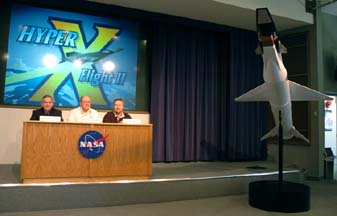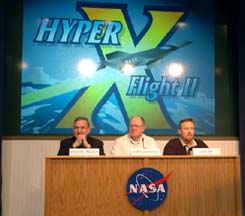
(Download a higher resolution picture by clicking on any picture
below. The photographs on the right side of the page were taken by
the photographers of the NASA
Dryden Flight Research Center.) 
The second X-43A Hyper-X mission is scheduled for launch from NASA's NB-52B mothership on Saturday, March 27. It will be dropped from the NB-52B about fifty miles from the coast of Southern California at an altitude of 40,000 feet. The objective of the mission is to demonstrate air-breathing powered flight at mach-7
 On Wednesday, March 24 NASA Dryden Flight Research Center hosted a
press briefing about the upcoming X-43A mission.
On Wednesday, March 24 NASA Dryden Flight Research Center hosted a
press briefing about the upcoming X-43A mission.
 Program Manager Vincent Rausch, Chief Engineer Griffin Corpening, and
Dryden Project Manager Joel Sitz outlined the objectives of the
Hyper-X program and the X-43A flight test.
Program Manager Vincent Rausch, Chief Engineer Griffin Corpening, and
Dryden Project Manager Joel Sitz outlined the objectives of the
Hyper-X program and the X-43A flight test.
The X-43A Hyper-X is the first free flight Supersonic Combustion Ramjet (SCRamjet) testbed. It is intended to fly under its own power at mach 7. This will be the first demonstration of flight at that speed powered by an air-breathing engine.
The X-43A stack was launched for the first time on June 2, 2001. Fifteen seconds after launch, the control system of the booster rocket failed. It yawed uncontrollably and had to be destroyed by the range safety officer.
 X-43A Hyper-X flight vehicle 2 on display at the 2002 Edwards Air
Force Base open house. The copper combustion chamber is visible below
the yellow caution tape.
X-43A Hyper-X flight vehicle 2 on display at the 2002 Edwards Air
Force Base open house. The copper combustion chamber is visible below
the yellow caution tape.
The twelve-foot long X-43A vehicle is mounted on a modified version of the first stage of an Orbital Sciences Pegasus booster. Because the Hyper-X mission does not require the full capability of the Pegasus booster, it has been modified by the removal of 3,300 pounds of solid fuel propellant.
If all goes as planned on Saturday afternoon, the Pegasus will pitch up as it does on a typical satellite launch, but then it will pitch over to level flight at 100,000 feet altitude. It will accelerate to mach-7.
Then the X-43A SCRamjet will separate from the booster. Fuel will be introduced into the combustion chamber, which is manufactured largely of copper, for ten seconds. After engine burn-out, the Hyper-X will glide for 400 miles to an impact point in the Pacific Ocean.
Ten seconds of supersonic combustion data represents a thousand-fold increase in the sum of data from ground-based facilities. Project managers pointed out that ten seconds of flight time represented ten miles of flight.
Observers from Lancaster to the Gaviota Coast may expect to see the NB-52B and its Boeing-McDonnel-Douglas F/A-18B Hornet escort flying overhead shortly after noon. It will cross the coast near Refugio Beach, about 15 miles west of Santa Barbara at about 12:20 P.M.
The launch of the Hyper-X stack is scheduled for approximately 1:00 P.M. It may be visible from the south coast of Santa Barbara County as it pulls up into a climb to 100,000 feet altitude, levels off, and accelerates under rocket power to mach-7.
A third X-43A airframe is scheduled to demonstrate air-breathing powered flight at mach-10 this coming fall. The proposed X-43C has been cancelled.
Supersonic Combustion Ramjet technology will allow flight in the atmosphere at speeds several times faster than the Lockheed SR-71A Blackbird. All current jet engines slow the air moving through the combustion chamber to subsonic velocity by compressing it into a much smaller volume. As the air is compressed, it gets hotter.
As airspeed increases to 3,000 miles per hour and above, the air entering the inlet has to be compressed so much that it is heated to temperatures that will melt the engine. The solution is to allow the air to go through the combustion chamber at supersonic velocity. That way, it does not need to be compressed as much and its temperature isn't as high.
The Supersonic Combustion Ramjet gets its oxygen from the atmosphere, allowing great savings in propellant weight compared to rocket engines. SCRamjet propelled vehicles could serve as the first stage of satellite launching boosters. They could transport passengers, packages, or other payloads halfway around Earth in just a few hours.
The first X-43A was lost when the rudder actuator of its modified Pegasus booster stalled under unexpectedly high loads as it was accelerating through transonic flight. The primary reason for the failure was the decision to launch the mission at 20,000 feet altitude instead of the 40,000 feet launch altitude of a typical Pegasus satellite launch mission on the basis of flawed models of the transonic aerodynamics of the vehicle and the flight control system actuators.
The first Hyper-X mission was launched at a lower altitude because they had extra fuel to burn. The Hyper-X mach-7 mission profile does not require the full capability of the Pegasus booster, so excess propellant was to be expended by climbing an additional 20,000 feet through denser air.
The X-43A stack began an unanticipated roll oscillation as it accelerated in the relatively dense air at the lower altitude. It wobbled from side to side more than twice per second, each time farther than the time before. The control surface actuators were subjected to higher forces than had been anticipated. The rudder actuator stalled and the rocket yawed out of control. As the sideslip angle increased, aerodynamic forces tore the stabilizer fins from the booster.
Link to NASA's report on the X-43A mishap (.pdf)
In order to prevent a recurrence of the X-43A mishap, the second mission will be launched at 40,000 feet. 3,300 pounds of excess solid fuel propellant has been removed from the vehicle.
Link to the NASA Dryden X-43A Hyper-X Photo Gallery.
 The X-43A Hyper-X
supersonic combustion ramjet testbed was launched three times. It successfully demonstrated Scramjet operation at Mach 7 and Mach 9.6
The X-43A Hyper-X
supersonic combustion ramjet testbed was launched three times. It successfully demonstrated Scramjet operation at Mach 7 and Mach 9.6
 Books
about Lifting Bodies, Edwards Air Force Base, and the X-43 available
from
Books
about Lifting Bodies, Edwards Air Force Base, and the X-43 available
from

 The
X-Planes: X-1 to X-45: 3rd Edition by
Jay Miller
The
X-Planes: X-1 to X-45: 3rd Edition by
Jay Miller
 Flying
Without Wings : Nasa Lifting Bodies and the Birth of the
Space Shuttle by
Milton O. Thompson
Flying
Without Wings : Nasa Lifting Bodies and the Birth of the
Space Shuttle by
Milton O. Thompson
 Test
Colors: The Aircraft of Muroc Army Airfield and Edwards Air Force
Base by
Rene Francillon
Test
Colors: The Aircraft of Muroc Army Airfield and Edwards Air Force
Base by
Rene Francillon
 X-Planes
at Edwards (Enthusiast Color Series) by
Steve Pace
X-Planes
at Edwards (Enthusiast Color Series) by
Steve Pace
 Edwards
Air Force Base : Open House at the USAF Flight Test Center 1957-1966
: A Photo Chronicle of Aircraft Displayed (Schiffer Military
History) by
Robert D. Archer
Edwards
Air Force Base : Open House at the USAF Flight Test Center 1957-1966
: A Photo Chronicle of Aircraft Displayed (Schiffer Military
History) by
Robert D. Archer
 Angle
of Attack : Harrison Storms and the Race to the Moon by Mike
Gray. The biography of Harrison Storms, who was instrumental in the
development and operation of the X-15.
Angle
of Attack : Harrison Storms and the Race to the Moon by Mike
Gray. The biography of Harrison Storms, who was instrumental in the
development and operation of the X-15.
 At
the Edge of Space : The X-15 Flight Program by Milton O.
Thompson. The story of test flying the X-15 from the point of view of
the pilot.
At
the Edge of Space : The X-15 Flight Program by Milton O.
Thompson. The story of test flying the X-15 from the point of view of
the pilot.
Send a message to Brian.
Go to home page of the Goleta Air and Space Museum.